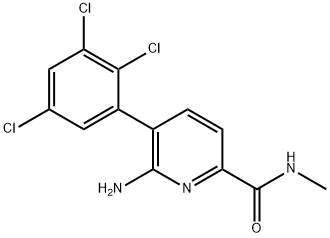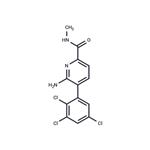PF-01247324 is a blocker of the tetrodotoxin-resistant (TTX-R) sodium channel Nav1.8 (IC50 = 0.19 μM for human Nav1.8). It is selective for Nav1.8 over Nav1.1, Nav1.2, Nav1.5, and Nav1.7 channels (IC50s = 13, 12.8, 9, and 19 μM, respectively) as well as ether-a-go-go (ERG) potassium channels (IC50 = 30 μM). PF-01247324 blocks Nav1.8 channels in a VSP-FRET assay using HEK293 cells (IC50 = 2.6 μM). In vivo, PF-01247324 (100 mg/kg) reduces phase 2 flinching in a rat model of formalin-induced persistent pain. It increases latency to lift the inflamed paw and latency to paw withdrawal in rat models of carrageenan-induced thermal hyperalgesia and mechanical hyperalgesia induced by complete Freund''s adjuvant (CFA), respectively.
6-Amino-N-methyl-5-(2,3,5-trichlorophenyl)picolinamide is a Nav1.8 modulators that demonstrate efficacy in preclinical models of neuropathic and inflammatory pain, attenuates nociception and sensory neuron excitability.
In humans, PF-01247324 [6-amino-5-(2, 3, 5-trichloro-phenyl)-pyridine-2-carboxylic acid methylamide] prevents native tetrodotoxin-resistant (TTX-R) currents in dorsal root ganglion (DRG) neurons.
This novel oral NaV1.8 blocker (FW = 330.59 g/mol) attenuates nociception and neuronal excitability by selectively targeting voltage-gated sodium transporter NaV1.8, with much weaker action against NaV1.1, NaV1.2, NaV1.4, NaV1.5, NaV1.6, and NaV1.7 transporters. PF-01247324 inhibited native tetrodotoxin-resistant (TTX-R) currents in human dorsal root ganglion (DRG) neurons (IC50 = 331 nM) and in recombinantly expressed hNav 1.8 (IC50 = 196 nM), with 50-fold selectivity over recombinantly expressed TTX-R hNav 1.5 channels (IC50 ~ 10 μM) and 65-100 greater selectivity over TTX-sensitive (TTX-S) channels (IC50 ~ 10-18 μM). Native TTX-R currents in small diameter rodent DRG neurons were inhibited with an IC50 of 448 nM, and the block of both human recombinant Nav1.8 and TTX-R from rat DRG neurons was both frequency and state�dependent. Unlike previously published NaV1.8 blockers, PF-01247324 demonstrates frequency-dependence, and off-target frequency-dependence at other sodium channel subtypes may reduce its selectivity window. The majority of small molecule sodium channel blockers interact at the local anesthetic binding site, which due to a high level of sequence homology across voltage-gated sodium channel subtypes seems an unlikely site for interaction of selective agents such as PF-01247324. The majority of small molecule sodium channel blockers interact at the local anesthetic binding site, which due to a high level of sequence homology across voltage-gated sodium channel subtypes seems an unlikely site for interaction of selective agents such as PF-01247324

